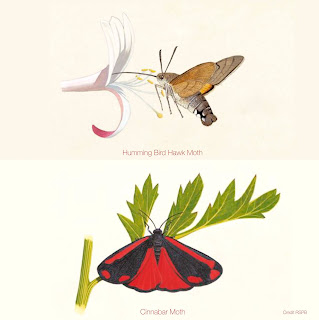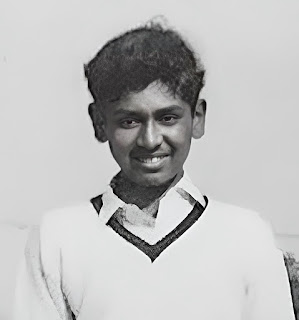CHARNEY HALL Entomology
There once was a fine, french polished, mahogany cabinet that lived in the Memorial Hall along the right hand wall, on a pier between two windows, just short of the piano. The cabinet had many drawers which spanned the full width of the carcass. Each drawer had 2 turned mahogany button knobs. If any curious boy opened the unlocked framed front it was possible to pull out each drawer in turn to view the contents.
The cabinet smelt of camphor and it was only when the drawers were opened that the source of the smell became clear. Each drawer was sealed with a glass top and beneath this could be seen rows of butterflies and moths arranged in variety. The camphor crystals, we were informed, were to prevent small invading insects from damaging the immaculately pinned specimens.
Several boys, having seen this magnificent collection, were hooked and immediately developed an all-consuming interest in entomology - ‘the scientific study of insects and their relationship to humans, the environment and other organisms’. We were following in the footsteps of the school’s founder, George Podmore whose collection it was and who may have bequeathed it to the school. But in reality the cabinet had probably been left by his son Conrad Podmore when Charney Hall was hurriedly sold, due to his failing health, to Maxwell Duncan and Raymond Hirst in 1937.
The fact that we had to catch, kill, relax, pin and set these insects on boards did not sink in until our first expedition on Hampsfell.
The majority of the specimens had been caught locally, although there were some rare and some foreign varieties, and we stood in awe and disbelief that such an extensive collection could have been amassed in, of all places, Grange-over-Sands.
Butterflies : Large Whites, Small Whites, Tortoiseshells, Peacocks, Red Admirals, Meadow Browns and Blues.
Moths: Yellow Underwings, Peppers, Magpies, Tigers, Puss Moths and Poplar Hawks.
There they all were, standing to attention, in regimented rows upon rows, carefully pinned with wings outstretched to display their unique beauty.
We were informed that the reason for such pervasive extermination was to study over time and place the minute changes that had occurred in the delicate patterns and colouration caused by the arrangement of the thousands of iridescent microscopic scales on their wings.
We couldn’t see any difference....but what we could appreciate was the tremendous variety of insect life that we had thus far not really been aware of.
Fellow entomologists at Charney Hall (in alphabetical order and not notoriety or reputation) were as follows : P. Becket*, M. Coxey, Haigh, M. Pemberton and the Toulmin brothers.
*Peter Becket sadly died as a result of a mountaineering accident in the Alps some years after he left Charney. I had the unenviable task of breaking the news to Maxwell Duncan. Let this post be a tribute to him - an intelligent, popular boy from the Isle of Man.
Some boys spent an enjoyable time (see Reminiscences 2) seeking the eggs and caterpillars of Poplar Hawk and Puss Moths. They were to be found on the leaves of White Poplar trees located along the high limestone boundary wall, fronting Ashmount Road. All were endowed with a natural camouflage evolved over millions of years before Charney was founded. The caterpillars looked like curled leaves and the eggs had a greenish hue which, together with their small size, ensured that only the sharpest of eyes would see them. The height of the trees meant that only a limited proportion of any tree’s budding insect population could be collected.
Walks on the fell gave those interested in catching butterflies a chance to add to their collection. Whilst the dull Meadow Browns flapped lazily over the clumps of green bracken, here flew the Fritillaries and the Blues, the fastest and most beautiful butterflies in that order. To net a Fritillary you had to be quick-witted, fast and be in possession of a large net. I only qualified in one of the aforementioned categories!
The Common Blue butterfly was a delight to behold. So small and beautifully detailed on the underside of the underwing. The dazzling iridescent blue of its topside looked almost metallic.
Yellow Underwing moths were very common, often discovered on the window frames and ledges in the Memorial Hall. They were easily overlooked due to their dull brown over-wing when at rest but once disturbed, their yellow underwing flashed as the moth escaped.
Maxwell Duncan’s ultra violet moth trap, put out on the tennis court on the night of a full moon attracted countless varieties of moths.
Here I include a description included in ‘Reminiscences 1’:
“ Once or twice in the summer term, on a still night with full moon, Maxwell Duncan would set the moth trap out on
the grass tennis court. It was constructed out of a wooden box and topped by a plunging acetate funnel with an
ultra violet lamp suspended on a frame over the opening. An egg tray was placed in the bottom of the box so that
any moths that became entrapped could hide from the shimmering purple light. In the morning it was with great
anticipation that the 'privileged few' could visit the trap to view the night's catch. Poplar hawks, eyed hawks, puss
moths, tiger moths, ermines, yellow underwings and strange moths that looked like broken birch wood twigs complete with silver bark wings. On a clear moonlit night, when the conditions were just right, many moths would be caught. The hawk moths were spectacular because of their size and unique wing configuration when at rest and the tiger moths because of their bright, garish but beautiful colouring. The vision of so many varieties of moths gave us a brief insight into the diverse complexity of nature and the undiscovered nocturnal world that was until that time, completely unbeknown to us.”
A Death’s Head Hawk moth, illustrated at the top of this post, was caught by senior master Mr Topham. It was discovered when the moth became trapped in a door hinge and emitted a squeak - probably the only moth that is able to communicate in this way! This moth is probably the largest seen in the UK having a wing span of 120-130mm.








Comments